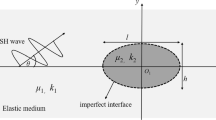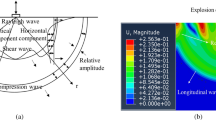Abstract
Purpose
Cracks widely exist in soil or rock. Its existence and complexity cannot be ignored for the safety of earthquake resistance and explosion resistance of aboveground or underground structures built in sites with cracks.
Methods
The site with cracks can be regarded as a local site, a high-precision indirect boundary element method (IBEM) is employed to investigate the wave scattered effects by semi-elliptical crack or straight crack in an elastic half-space under shock waves.
Results
The analysis results indicate that the buried depth of crack, the incidence angle of wave and the incidence frequency of wave have an obvious influence on the surface displacements and the displacements of medium around the crack, and the crack shape also has a large influence on the wave focusing effect. As the frequency increases, the displacements of surface and medium near the crack change more and more violently. The crack leads to the significant amplification of the displacement amplitude of half-space, and the peak of normalized amplitude near the resonance frequency is even greater than 10.
Conclusion
As a result, the special attention should be paid to the influence of cracks in anti-explosion and seismic design of underground structures.





















Similar content being viewed by others

References
Boore DM, Larner KL, Aki K (1971) Comparison of two independent methods for the solution of wave-scattering problems: response of a sedimentary basin to vertically incident SH waves. J Geophys Res 76(2):558–569
He Y, Sun W, Ly F-Y (2013) Comparison of boundary element method and finite-difference method for simulating seismic wave propagation in complex medium. Prog Geophys 28(2):0664–0678
Wu JL, Wu GC (2018) Finite difference method for acoustic-elastic coupled equation of seismic waves in the frequency domain. Chin J Geophys 61(6):2396–2408
Wand M, Jiang H, Hu Y (2005) Comparison between staggered grid finite difference method and stochastic method in simulating strong ground motions. Acta Seismol Sin 18(5):582–589
Zou G, Peng S, Yin C, Deng X, Chen F, Xu Y (2011) Modeling seismic wave propagation in a coal-bearing porous medium by a staggered-grid finite difference method. Min Sci Technol 21:727–731
Qian J, Wu S, Cui R (2013) Accuracy of the staggered-grid finite-difference method of the acoustic wave equation for marine seismic reflection modeling. Chin J Oceanol Limnol 31(1):169–177
Hwang RN, Lysmer J (1981) Response of buried structures to traveling waves. J Geotech Eng Div 107(2):183–200
Zhu DL, Bai CY (2011) Review on the seismic wavefield forward modelling. Prog Geophys 26(5):1588–1599
Esmaeili M, Vahdani S, Noorzad A (2005) Dynamic response of lined circular tunnel to plane harmonic waves. Tunnel Undergr Space Technol Incorp Trench Technol Res 21(5):511–519
Liu Z, Sun S, Zhao R, Wang D (2017) Two-dimensional simulation of high-frequency scattering of seismic waves by local sites based on fast multi-pole boundary element method. Chin J Geotech Eng 39(11):2017–2025
Zhang X, Liu Z, He Y (2018) Simulation of seismic response of adjacent mountains for incident Rayleigh waves using the indirect boundary element method. World Earthq Eng 34(4):8–15
Gao Y, Mei Z (2019) A doubly asymptotic open boundary element for hydrodynamic pressure wave analysis based on the ABAQUS and its application. J Vib Shock 38(10):38–42
Stamos AA, Beskos DE (1996) 3D seismic response analysis of long lined tunnels in half-space. Soil Dyn Earthq Eng 15(2):111–118
Ma X, Zou Z, Shao C, Huang W (1989) Study on scattering of elastic waves (P-wave and SV-wave) in plane boundary cracks of layered medium. Acta Aeronautica ET Astronautica Sinica 09:434–441
Wang Y, Wang Y (1993) Dynamic stress intensity factor of arc-shaped interface crack under shear wave. J Solid Mech 04:362–367
Wang Y, Wang W, Ma X, Zou Z (1997) Application of singular integral equation in crack elastic wave scattering. Adv Mech 01:40–56
Jiang F (2013) Rayleigh wave propagation characteristics underground cracks. J Xiamen Univ Technol 21(02):70–74
Tadeu A, Godinho L, António J et al (2007) Wave propagation in cracked elastic slabs and half-space domains—TBEM and MFS approaches. Eng Anal Boundary Elem 31(10):819–835
Boströ MA (2003) Review of hypersingular integral equation method for crack scattering and application to modeling of ultrasonic nondestructive evaluation [M]. Environmental social science: human-environment interactions and sustainability. Wiley, New York, pp 1–24
Murai Y (2007) Scattering attenuation, dispersion and reflection of SH waves in two- dimensional elastic medium with densely distributed cracks. Geophys J Int 168(1):211–223
Carcione JM (2015) Scattering of elastic waves by a plane crack of finite width in a transversely isotropic medium. Int J Numer Anal Meth Geomech 22(4):263–275
Liu Z, He C, Wang H et al (2019) Two-dimensional FM-IBEM solution to the broadband scattering of elastic waves in a fluid-saturated poroelastic half-space. Eng Anal Boundary Elem 104:300–319
Phurkhao P (2016) Dynamic stress-intensity factors of an in-plane shear crack in saturated porous medium. Theor Appl Crack Mech 85:345–354
Sih GC, Loeber JF (1969) Wave propagation in an elastic solid with a line of discontinuity or finite crack. Q Appl Math 27(2):193
Wang D, Wang L, Ding P (2016) The effects of crack permeability on acoustic wave propagation in the porous medium: a microscopic perspective. Ultrasonics 70:266–274
Galvin RJ, Gurevich B (2007) Scattering of a longitudinal wave by a circular crack in a fluid-saturated porous medium. Int J Solids Struct 44(22–23):7389–7398
Jin B, Zhong Z (2002) Dynamic stress intensity factor (Mode I) of a penny-shaped crack in an infinite poroelastic solid. Int J Eng Sci 40(6):637–646
Dineva P, Wuttke F, Manolis G (2012) Elastic Wave field evaluation in discontinuous poroelastic medium by Bem: SH-waves. J Theor Appl Mech 42(3):75–100
Song Y, Hu H, Rudnicki JW (2017) Normal compression wave scattering by a permeable crack in a fluid-saturated poroelastic solid. Acta Mech Sin 33(2):1–12
Song Y, Hu H, Rudnicki JW (2017) Dynamic stress intensity factor (Mode I) of a permeable penny-shaped crack in a fluid-saturated poroelastic solid. Int J Solids Struct 110–111:127–136
Wu YX, Gao YF, Zhang N, Li DY (2016) Simulation of spatially varying ground motions in V-shaped symmetric canyons. J Earthquake Eng 20(6):992–1010
Zhang N, Zhang Y, Gao YF (2019) An exact solution for SH-wave scattering by a radially multilayered inhomogeneous semicylindrical canyon. Geophys J Int 217(2):1232–1260
Gupta S, Dutta R, Das S (2020) Love-type wave propagation in an inhomogeneous cracked porous medium loaded by heterogeneous viscous liquid layer. J Vib Eng Tech 9(3):433–448
Sang S, Sandgren E (2019) Study of in-plane wave propagation in 2-dimensional anisotropic elastic metamaterials. J Vib Eng Technol 7:63–72
Liu ZY, Huang L, Liang JW, Wu CQ (2019) A three-dimensional indirect boundary integral equation method for modeling elastic wave scattering in a layered half-space. Int J Solids Struct 169:81–94
Zhongxian L, Lishuang Z, Dong W (2017) IBEM broadband simulation of seismic response of sedimentary valleys under plane P, SV and Rayleigh waves China. Earthq Eng J 1:1000–1844
Ba Z, Fu Z, Liu Z, Sang Q (2020) A 2.5D IBEM to investigate the 3D seismic response of 2D topographies in a multi-layered transversely isotropic half-space. Eng Anal Boundary Elem 113:382–401
Avila-Carrera R, Rodríguez-Castellanos A, Sánchez-Sesma FJ et al (2009) Rayleigh-wave scattering by shallow cracks using the indirect boundary element method. J Geophys Eng 6(3):221–230
Liu Z, Huang L, Liang J et al (2019) A three-dimensional indirect boundary integral equation method for modeling elastic wave scattering in a layered half-space. Int J Solids Struct 169:81–94
Liang J, Liu Z, Huang L et al (2019) The indirect boundary integral equation method for the broadband scattering of plane P, SV and Rayleigh waves by a hill topography. Eng Anal Boundary Elem 98:184–202
Huang L, Liu Z, Wu C et al (2019) The scattering of plane P, SV waves by twin lining tunnels with imperfect interfaces embedded in an elastic half-space. Tunn Undergr Space Technol 85:319–330
Yu Y, Liu TY, Zhang JM (2013) Wave function combination method for solving two-dimensional elastic half-space scattering problem. China Earthq Eng J 01:1000–1844
Liu ZX, Wang DW, Wu FJ, Zhao RB (2014) Fast boundary integral equation method for SH wave scattering in elastic half-space. Earthq Eng Eng Dynam S1:1000–1301
Chen ZG (2019) Solution of scattering of planar P waves on holes by least square method. Earthquake engineering and engineering dynamics. Earthq Eng Eng Vib 6:1000–1301
Xu Y (2018) Influence of cracks on scattering of plane P-waves in elastic half-space[D]. Tianjin Chengjian University, Tianjin, China
Acknowledgements
This work was supported by the National Natural Science Foundation of China under grants (No.51878108, No.51908401), the key projects of Tianjin science and technology support program (No.17YFZCSF01140), and Tianjin Municipal Science and Technology Bureau (No.19PTZWHZ00080).
Author information
Authors and Affiliations
Corresponding author
Additional information
Publisher's Note
Springer Nature remains neutral with regard to jurisdictional claims in published maps and institutional affiliations.
Rights and permissions
About this article
Cite this article
Zhang, H., Zhao, T., Wang, D. et al. Wave Scattering by Crack Under Shock P-Wave in an Elastic Half-Space. J. Vib. Eng. Technol. 10, 425–443 (2022). https://doi.org/10.1007/s42417-021-00385-9
Received:
Revised:
Accepted:
Published:
Issue Date:
DOI: https://doi.org/10.1007/s42417-021-00385-9



